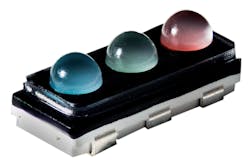Cree adds RGB surface-mount LEDs for color directional signage
Cree has announced the CV94D-FCC LED that integrates three emitters in a compact surface-mount device (SMD) package. The package includes tightly packed red, green, and blue (RGB) emitters enabling full-color signs or displays based on solid-state lighting (SSL) technology. Cree identified the target application as intelligent transportation systems, with a primary example being dynamically changeable signs that are increasingly being suspended above freeways.
We have written quite a lot of late about LED-based, directly- or self-emissive color displays. Self-emissive means the LEDs deliver the video images as opposed to, say, being used for backlights in a liquid-crystal display (LCD). The technology has long been used in applications such as sports stadium video boards and façades at locations such as Times Square in New York. Finer pixel pitch is even bringing the technology indoors.
In the transportation segment, meanwhile, dynamic signs allow cities and states to deliver important information to drivers. In the US, for example, the signs broadcast what are called Amber Alerts when a child is abducted. They also notify drivers of road closures and lately have been used to display coronavirus reminders.
Most of the freeway signage has been based on amber monochromatic technology. But signs that are either full color, or even that just have a portion of the display capable of color, can do a better job of grabbing attention and expressing a message.
The requirements for such transportation-oriented signage and façade displays share many of the same requirements from RGB LEDs and yet need difference characteristics in some aspects. For example, the tightly packed and aligned LEDs, with each package forming a pixel, ensure good far-field performance in terms of uniformity and precision. In other words, the display looks sharp from afar. Many transportation displays have used discrete, through-hole LEDs in the past and it is far harder to manufacture a precise display with such technology. The integrated RGB emitters also result in better color mixing.
Where transportation display requirements differ considerably from, say, façade displays is in viewing angle. A display board on a building or in a sports stadium needs a very broad viewing angle so as many people as possible can see the images. The freeway sign needs the brightness of the LEDs focused much more narrowly so that drivers can see the sign message from as far away as possible. Cree said the CV94D is the brightest LED on the market with a 30° beam pattern.
“Cree’s new CV94D takes the same stuff that makes Times Square look so good and puts it into a package meant for the freeway signs,” said Paul Scheidt, product marketing manager at Cree. “It’s not as high of resolution as the Times Square versions, since it doesn’t need to be, and it has the tighter beam angle that freeway signs like, but Times Square does not.”
The color, beam, and uniformity combine with the ease of manufacturing as benefits for manufacturers of signs. SMD LEDs are assembled on automated printed-circuit board (PCB) assembly lines. And precision is a given.
“When Cree showed us prototypes of the CV94D, we recognized a component that would allow us to improve brightness and quality as well as reduce production costs across our entire product line,” said Milan Patel, vice president of engineering at Ledstar. “The CV94D is a win-win for many of our signage products.”
Cree has long been one of the leading suppliers of LEDs for the directly-emissive display market over a range of applications. All the way back in 2010, we covered a video display project based on Cree LEDs at the American Airline Center sports arena in Dallas, TX.
For up-to-the-minute LED and SSL updates, why not follow us on Twitter? You’ll find curated content and commentary, as well as information on industry events, webcasts, and surveys on our LinkedIn Company Page and our Facebook page.

Maury Wright | Editor in Chief
Maury Wright is an electronics engineer turned technology journalist, who has focused specifically on the LED & Lighting industry for the past decade. Wright first wrote for LEDs Magazine as a contractor in 2010, and took over as Editor-in-Chief in 2012. He has broad experience in technology areas ranging from microprocessors to digital media to wireless networks that he gained over 30 years in the trade press. Wright has experience running global editorial operations, such as during his tenure as worldwide editorial director of EDN Magazine, and has been instrumental in launching publication websites going back to the earliest days of the Internet. Wright has won numerous industry awards, including multiple ASBPE national awards for B2B journalism excellence, and has received finalist recognition for LEDs Magazine in the FOLIO Eddie Awards. He received a BS in electrical engineering from Auburn University.





